Drawing on the theme of the story. Teaching children a story from a picture and a series of plot pictures
A series of plot pictures intended for independent compilation of stories by children.
Balloon.
An adult asks the child to arrange the plot pictures in a logical sequence, answer the questions with a full answer and compose a story on their own.
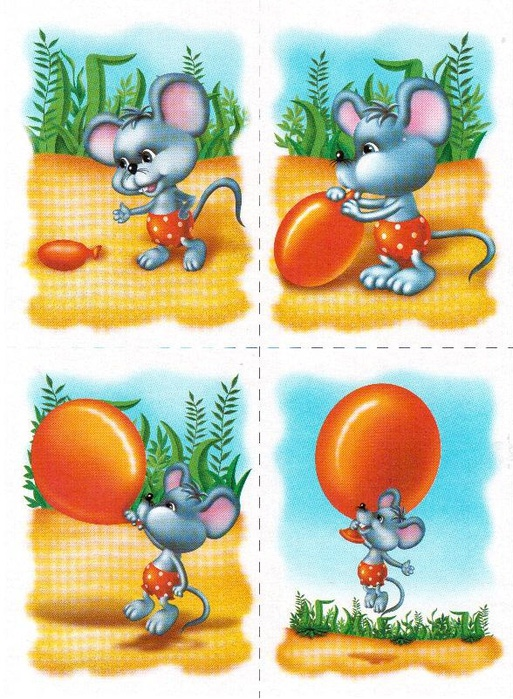
1. Answer the questions:
Who and where lost balloon?
Who found the ball on the field?
What was the mouse and what was his name?
What did the mouse do on the field?
What did the mouse do with the ball?
How did the ball game end?
2. Compose a story.
Sample story "Balloon".
The girls were tearing cornflowers in the field and lost the balloon. little mouse Mitka ran across the field. He was looking for sweet grains of oats, but instead he found a balloon in the grass. Mitka began to inflate the balloon. He blew and blew, and the ball got bigger and bigger until it turned into a huge red ball. A breeze blew, picked up Mitka with the balloon and carried him over the field.
Caterpillar house.

1. Answer the questions:
Who are we going to write about?
Tell me, what was the caterpillar and what was its name?
What did the caterpillar do in the summer?
Where did the caterpillar once crawl? What did you see there?
What did the caterpillar do to the apple?
Why did the caterpillar decide to stay in the apple?
What did the caterpillar make in her new home?
2. Compose a story.
Sample story "House for the caterpillar."
The story is not read to the child, but can be used as an aid in case of difficulties in compiling a children's, author's story.
Lived - lived a young, green caterpillar. Her name was Nastya. She lived well in the summer: she climbed trees, ate leaves, basked in the sun. But the caterpillar did not have a house and she dreamed of finding it. Once a caterpillar crawled up an apple tree. I saw a big red apple and started to nibble it. The apple was so delicious that the caterpillar did not notice how it gnawed right through it. The caterpillar Nastya decided to stay in the apple. She felt warm and comfortable there. Soon the caterpillar made a window and a door in its dwelling. Got a wonderful house
New Year's preparations.
An adult asks the child to arrange the plot pictures in a logical sequence, answer the questions with a complete answer and compose a story on their own.
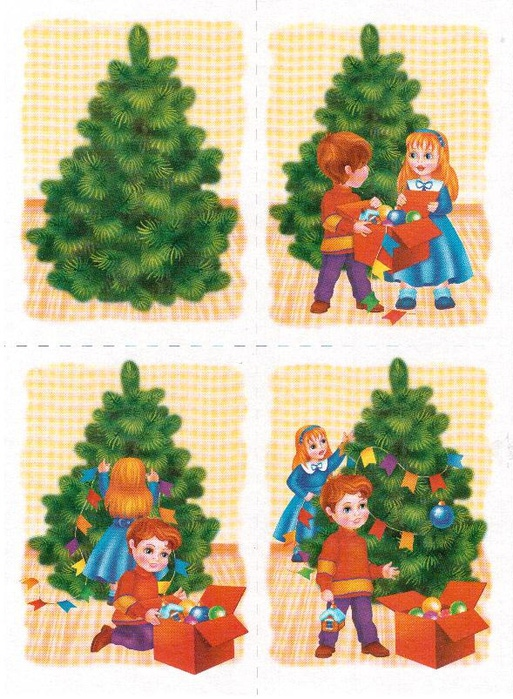
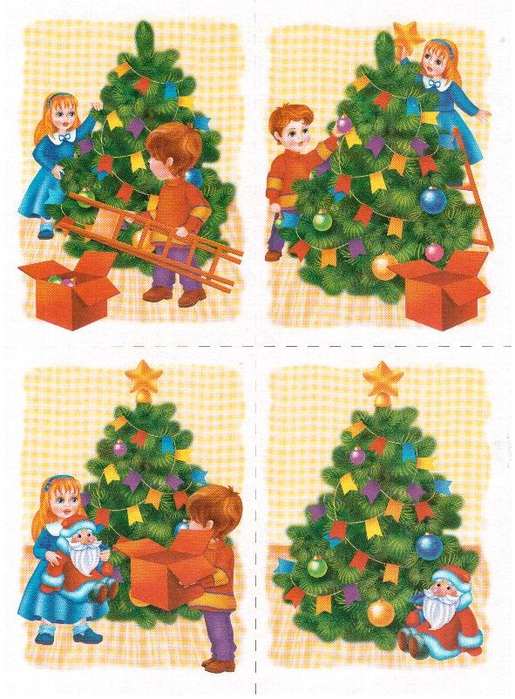
1. Answer the questions:
What holiday was coming up?
Who do you think bought the tree and put it in the room?
Tell me what the tree was like.
Who came to decorate the Christmas tree? Think of names for the children.
How did the children decorate the Christmas tree?
Why was the ladder brought into the room?
What did the girl eat on top of her head?
Where did the children put the toy Santa Claus?
2. Compose a story.
Sample story "New Year's preparations."
The story is not read to the child, but can be used as an aid in case of difficulties in compiling a children's, author's story.
Approached New Year's celebration. Dad bought a tall, fluffy, green Christmas tree and put it in the hall. Pavel and Lena decided to decorate the Christmas tree. Pavel took out a box with Christmas decorations. Children hung flags and colorful toys on the Christmas tree. Lena could not reach the top of the spruce and asked Pavel to bring a ladder. When Pavel installed a ladder near the spruce, Lena attached to the top of the spruce golden star. While Lena was admiring the decorated Christmas tree, Pavel ran to the pantry and brought a box with a toy Santa Claus. The children put Santa Claus under the Christmas tree and ran away from the hall satisfied. Today, parents will take their children to the store to choose new costumes for the New Year's carnival.
Bad walk.
An adult asks the child to arrange the plot pictures in a logical sequence, answer the questions with a complete answer and compose a story on their own.

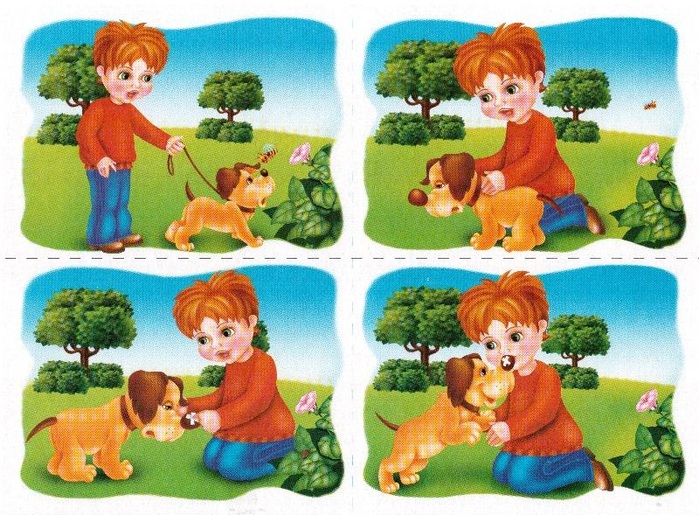
1. Answer the questions:
Name who you see in the picture. Come up with a name for the boy and a nickname for the dog.
Where the boy walked with his dog
What did the dog see and where did it run?
Who flew out of a bright flower?
What was the little bee doing in the flower?
Why did the bee bite the dog?
What happened to the dog after the bee sting?
Tell me how the boy helped his dog?
2. Compose a story.
Sample story "Unsuccessful walk".
The story is not read to the child, but can be used as an aid in case of difficulties in compiling a children's, author's story.
Stas and the dog Soyka were walking along the alley of the park. Jay saw a bright flower and ran to smell it. The dog touched the flower with its nose and it swayed. A small bee flew out of the flower. She collected sweet nectar. The bee got angry and bit the dog on the nose. The dog's nose was swollen, tears flowed from his eyes. Jay lowered her tail. Stas was worried. He took a band-aid out of his bag and stuck it over the dog's nose. The pain subsided. The dog licked Stas on the cheek and wagged its tail. Friends hurried home.
Like a mouse painting a fence.
An adult asks the child to arrange the plot pictures in a logical sequence, answer the questions with a complete answer and compose a story on their own.

1. Answer the questions:
Come up with a nickname for the mouse that you will talk about in the story.
What did the little mouse decide to do on the day off?
What did the mouse buy in the store?
Tell me what color was the paint in the buckets
What paint did the mouse paint the fence with?
With what color paints did the mouse draw flowers and leaves on the fence?
Think of a sequel to this story.
2. Compose a story.
A sample of the story "How the mouse painted the fence."
The story is not read to the child, but can be used as an aid in case of difficulties in compiling a children's, author's story.
On the day off, the little mouse Proshka decided to paint the fence near his house. In the morning Proshka went to the store and bought three buckets of paint from the store. I opened it and saw: in one bucket - red paint, in the other - orange, and in the third bucket - green paint. Mouse Prosha took a brush and began to paint the fence with orange paint. When the fence was painted, the mouse dipped a brush in red paint and painted flowers. Prosha painted leaves with green paint. When the work was done, friends came to visit the mouse to look at the new fence.
Duckling and chicken.
An adult asks the child to arrange the plot pictures in a logical sequence, answer the questions with a complete answer and compose a story on their own.
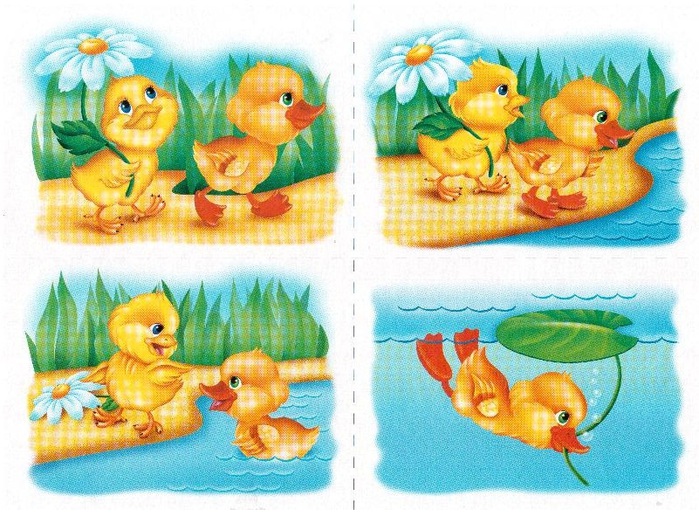

1. Answer the questions:
Come up with nicknames for the duckling and the chicken.
What time of year is shown in the pictures?
Where do you think the duckling and the chicken went?
Tell how friends crossed the river:
Why didn't the chicken go into the water?
How did the duckling help the chick swim to the other side?
How did this story end?
2. Compose a story.
Sample story "Duckling and chicken."
The story is not read to the child, but can be used as an aid in case of difficulties in compiling a children's, author's story.
On a summer day, the duckling Kuzya and the chicken Tsypa went to visit the turkey. The turkey lived with a turkey dad and a turkey mom on the other side of the river. Duckling Kuzya and chicken Tsypa came to the river. Kuzya plopped down into the water and swam. The chick did not go into the water. Chickens can't swim. Then the duckling Kuzya grabbed a green leaf of a water lily and put Chick on it. The chicken floated on a leaf, and the duckling pushed him from behind. Soon friends crossed to the other side and met with a turkey.
Successful fishing.
An adult asks the child to arrange the plot pictures in a logical sequence, answer the questions with a complete answer and compose a story on their own.
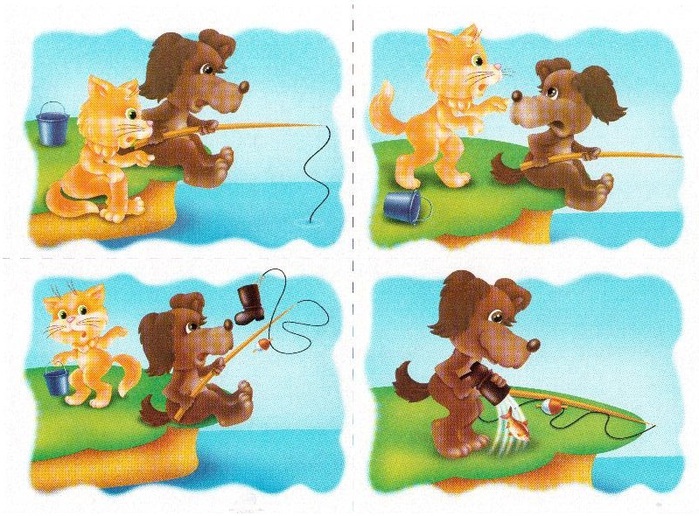
1. Answer the questions:
Who went fishing one summer? Come up with nicknames for the cat and dog.
What did your friends take with them?
Where did the friends settle down to fish?
What do you think the cat started screaming when he saw that the float went under the water?
Where did the cat throw the caught fish?
Why did the cat decide to steal the fish that the dog caught?
Tell me how the dog managed to catch the second fish.
Do you think the cat and the dog still go fishing together?
2. Compose a story.
Sample story "Successful fishing."
The story is not read to the child, but can be used as an aid in case of difficulties in compiling a children's, author's story.
One summer, Timothy the Cat and Polkan the dog went fishing. The cat took a bucket, and the dog took a fishing rod. They sat down on the bank of the river and began to fish. The float went under the water. Timofey began to shout loudly: "Fish, fish, pull, pull." Polkan pulled out the fish, and the cat threw it into the bucket. The dog threw the bait into the water a second time, but this time he caught an old boot. Seeing the boot, Timothy decided not to share the fish with Polkan. The cat quickly picked up the bucket and ran home for dinner. And Polkan poured water out of his boot, and there was another fish. Since then, the dog and the cat have not gone fishing together.
Resourceful mouse.
An adult asks the child to arrange the plot pictures in a logical sequence, answer the questions with a complete answer and compose a story on their own.

1. Answer the questions:
Come up with a name for the girl, nicknames for a cat, a mouse.
Tell me who lived in the girl's house.
What did the girl pour into the cat's bowl?
What did the cat do?
Where did the mouse run out and what did he see in the cat's bowl?
What did the little mouse do to drink milk?
What surprised the cat when she woke up?
Think of a continuation of this story.
2. Compose a story.
Sample story "Resourceful little mouse."
The story is not read to the child, but can be used as an aid in case of difficulties in compiling a children's, author's story.
Natasha poured milk into a bowl for the cat Cherry. The cat drank a little milk, put her ears on the pillow and fell asleep. At this time, the little mouse Tishka ran out from behind the closet. He looked around and saw milk in the cat's bowl. The mouse wanted milk. He climbed onto a chair and pulled a long macaroni out of the box. The little mouse Tishka quietly crept up to the bowl, put the macaroni in milk and drank it. Cherry the cat heard a noise, jumped up and saw an empty bowl. The cat was surprised, and the mouse ran back behind the closet.
How a crow grew peas.
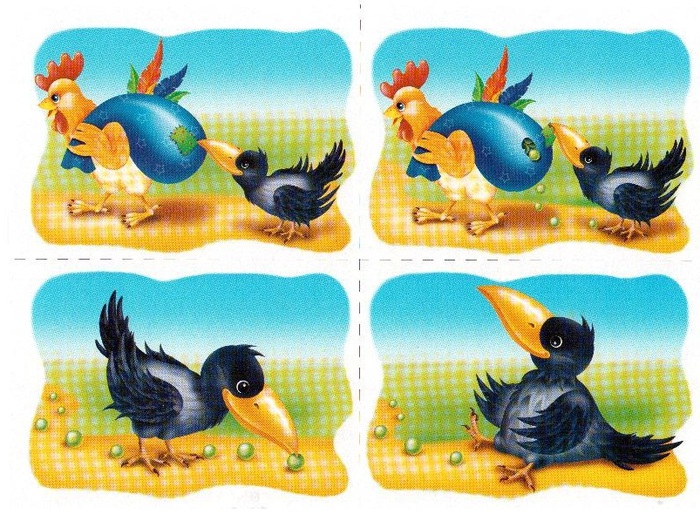
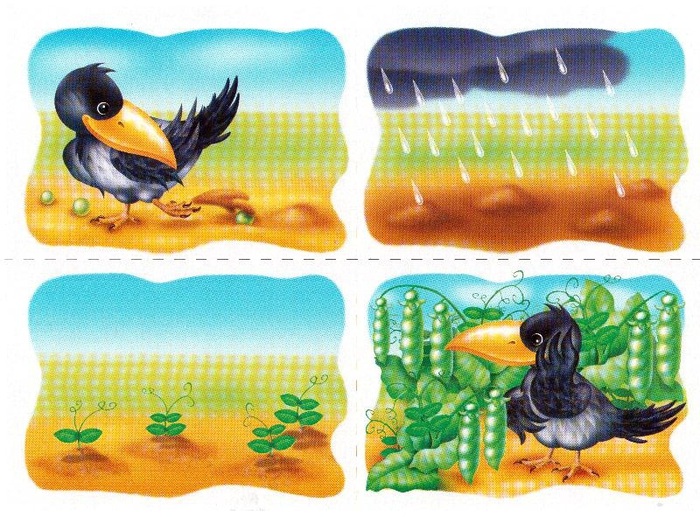
An adult asks the child to arrange the plot pictures in a logical sequence, answer the questions with a complete answer and compose a story on their own.
1. Answer the questions:
What time of year do you think the cockerel walked across the field?
What did the cockerel bring home?
Who noticed the rooster?
What did the crow do to eat the peas?
Why didn't the crow eat all the peas?
How did the bird sow pea seeds in the ground?
What appeared from the earth after the rain?
When did pea pods appear on plants?
Why was the crow happy?
2. Compose a story.
A sample of the story "How a crow grew peas."
The story is not read to the child, but can be used as an aid in case of difficulties in compiling a children's, author's story.
In early spring, a cockerel walked across the field and carried a heavy sack of peas over his shoulders.
The cockerel noticed the raven. She jabbed her beak at the sack and tore off the patch. Peas fell out of the bag. The crow began to feast on sweet peas, and when she had eaten, she decided to grow her crop. With its paws, the bird trampled several peas into the ground. Rain is coming. Very soon, young shoots of peas appeared from the ground. In the middle of summer, tight pods with large peas inside appeared on the branches. The crow looked at her plants and rejoiced at the rich harvest of peas that she managed to grow.
Formation of the correct competent speech- one of the main tasks in preparing children for school. great attention this is given in children's preschool. Quite a few important role The family plays in this matter. A child with a well-developed coherent speech easily enters into communication with others: he can clearly express his thoughts and desires, correctly and clearly formulate a question, agree with peers in kindergarten and school. Conversely, vague speech, poor vocabulary make it very difficult to communicate with peers and adults and often leave a heavy imprint on the character of the child.
At 6-7 years old, children with insufficient developed speech already usually aware of their difficulties, painfully feel them, become withdrawn, shy, and some - irritable. In the family, the child is often understood perfectly, and he does not experience difficulties, even if he has speech problems. However, gradually the child's social circle expands, and it is very important that others understand him well.
Therefore, the sooner (but in accordance with the age possibilities) we help him to master the norms of literate speech, the more confident he will feel.
Even more acute is the question of the development of speech at school, where the shortcomings of oral and writing can lead to specific disorders of reading (dyslexia) and writing (dysgraphia), the correction of which requires the serious work of a speech therapist.
Drawing up a story based on a series of plot pictures.
The ability to retell and tell independently plays an important role in the life of a child. This needs to be taught from an early age.
Good harvest.


In the spring, Tanya dug up the ground in the garden and planted tomato seedlings. Every morning the girl watered the young plants with warm water. Under the gentle rays of the sun green plants quickly gained strength and stretched upwards. In the summer, Tanya noticed that the plants had grown and bloomed. A few days later, instead of flowers, fruits appeared on thick branches - green tomatoes. At the end of summer, the tomatoes turned red. One afternoon, Tanya went to the garden and picked a full bucket of ripe, red tomatoes. Tanya has grown a good harvest!
1. Answer the questions:
At what time of the year did Tanya plant tomato seedlings?
How did Tanya take care of the plants?
What time of year do the plants bloom?
Tell me, what changes have occurred with the fruits on the branches of plants?
2. Retell the story.
Frog choir.
The adult asks the child to arrange the plot pictures in a logical sequence, answer the questions with a full answer and retell the story.
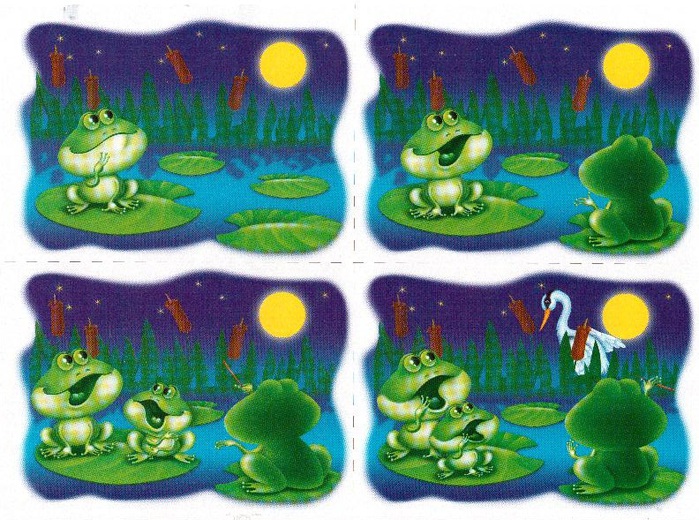
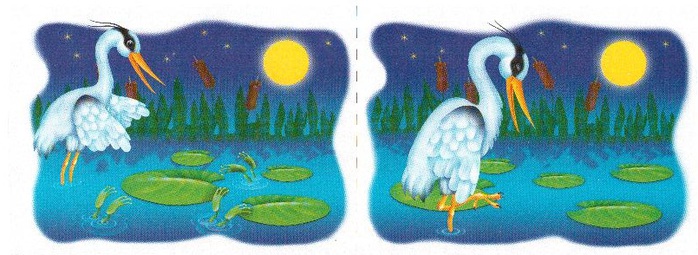
Pilka the little frog sat on a lotus leaf and looked at full moon. Suddenly, the frog Pulka jumped out of the water with a noise. Pilka croaked in surprise. Pilka and Pulka began to croak in every way. The frog Bulka joined them. And together they sang a cheerful song about life in the swamp. The frogs sang so cheerfully and loudly that they did not notice how they woke up the heron, the main enemy of the frogs. Pilka, Bulka and Pulka, seeing the heron, rushed into the water. The swamp became quiet. The heron was left without supper.
1. Answer the questions:
Which frog was the first to appear on a lotus leaf?
What did Pilka do?
Who suddenly jumped out of the water with a noise?
What was the name of the frog that was the last to jump out of the swamp?
What did Pilka, Pulka and Bulka do in the swamp?
Who was awakened by a cheerful song?
Why was the heron left without dinner?
2. Retell the story.
Pyramid.
The adult asks the child to arrange the plot pictures in a logical sequence, answer the questions with a full answer and retell the story.


Mom asked Lada to assemble a pyramid. The girl sat down on the warm carpet and set to work. First, she strung the largest orange ring, and then smaller rings: red and green. The blue ring and the yellow one remained on the floor. Timka the cat pushed the blue ring with his paw and it rolled across the floor. The cat was playing with a ring. Suddenly he threw a little ring with his paw and it fell on his head. The dog Alma ran up to the noise and began to bark at the cat. Timka the cat hissed and arched his back. The ring fell to the floor. At that moment, Alma grabbed the ring with her teeth and carried Lada. Lada took a blue ring from Alma and strung it on a pyramid. Behind the green ring, Lada strung a yellow one. The pyramid is ready! Lada shouted joyfully and ran to her mother.
1. Answer the questions:
What did Lada do?
Tell me in what order Lada laid out the rings.
What color rings were left lying on the floor?
Why did the blue ring roll on the floor?
Who came running to the noise?
What did Timka do?
What did Alma do?
Tell me, how did Lada finish collecting the pyramid?
2. Retell the story.
An amazing transformation.
The adult asks the child to arrange the plot pictures in a logical sequence, answer the questions with a full answer and retell the story.

There was a snowman outside the house. Instead of hands, he had sticks, instead of a nose, a carrot, instead of eyes, coals, and a bucket on his head. A sparrow flew and sat down to rest on the snowman's head. “Are you cold sparrow?” asked the snowman. ‘Yes, I’ll warm up and fly further’ Then the sun peeked out from behind the clouds. Sparrow warmed up, spread his wings, looked at the snowman and asked: “Snowman, are you cold?” Then the sparrow noticed that the snowman began to melt. The nose fell off, icicles hung instead of hands. The sun was hotter and hotter, the snowman lost weight, and the sparrow became so hot that he sang a cheerful song. The snowman is melting, which means spring will come soon. A few days later, the snowman melted completely. When the sparrow flew back to his friend the snowman, he saw a scarecrow in his place.
1. Answer the questions:
Where was the snowman? Tell me what he looked like?
Who flew past the snowman?
What were the snowman and sparrow talking about?
Why did the snowman melt?
What did the sparrow see when it flew to the snowman a few days later?
2. Retell the story.
Winter walk.
The adult asks the child to arrange the plot pictures in a logical sequence, answer the questions with a full answer and retell the story.

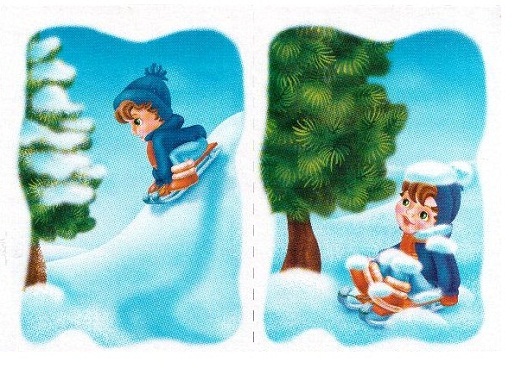
Winter has come and a lot of snow has fallen. The children made a high hill out of snow in the yard. The whole day the children rode down the hill, and at night the hill was covered with snow. In the morning the snowfall ended and little Sanya got ready for a walk. The boy put on warm felt boots, a jacket, tied a woolen scarf, picked up the sled and jumped out into the street. Sanya went up to the hill and did not recognize it; during the night it became even higher. The boy climbed up the hill, sat on the sled and rolled. There was a lot of snow, but the sledge glided well. Near a tall pine tree, Sanya slowed down. The fir branches swayed in the wind and clods of snow fell from the tree and covered the boy. Sana was having fun. How nice it is to go for a walk in winter!
1. Answer the questions:
What time of year is it?
What did the children in the yard make out of the snow?
Where is Sanya planning to go?
How did the boy dress for the walk?
Why did the hill in the yard get higher in the morning?
What did Sanya do on a walk?
Why was the boy covered in snow?
2. Retell the story.
Sand castle.
The adult asks the child to arrange the plot pictures in a logical sequence, answer the questions with a full answer and retell the story.

On a hot summer day, parents with their children Pasha and Natasha went to the beach. The water in the river was still cold and the children were not allowed to swim. On the bank of the river, the guys saw dry, clean, river sand, and Natasha suggested that Pasha build a sand castle. First, the guys, with the help of scoops and a bucket, poured a high hill. “We won’t be able to fashion anything out of dry sand,” said Natasha and suggested that Pasha wet the hill with water. The children took turns going to the river, collecting water in a bucket and pouring it on the dry sand. Soon all the sand became wet and the guys began to build a sand castle. When the castle tower was ready, the children started building the fortress wall. After an hour of work, the sand castle was ready and Pasha hoisted his paper hat on the highest tower. Natasha laughed and attached a green leaf to a low turret. Tomorrow the children will come to the beach with toys and start playing in their castle.
1. Answer the questions:
Where did the parents take Pasha and Natasha on a summer day?
What did the children see on the river bank?
What building did Natasha suggest Pasha build out of sand?
How was the construction? What did the children do first and then what?
What did Natasha attach to the low turret?
2. Retell the story.
Doll Lada.
The adult asks the child to arrange the plot pictures in a logical sequence, answer the questions with a full answer and retell the story.

Alla had a favorite Lada doll. Allah took care of her. One autumn, Alla was walking with Lada and stumbled. Doll Lada jumped out of her hands and fell into a puddle. Alla took out Lada and did not recognize her. The dress was soiled. At home, Alla put Lada on the table, poured warm water into a basin, washed the dress and hung it up to dry. When the dress was dry, Alla ironed it and put it on Lada. Alla and Lada were pleased.
1. Answer the questions:
What was the name of Alla's favorite doll?
What happened on the walk?
Tell us how Alla took care of the doll.
2. Retell the story.
Carnival costume.
The adult asks the child to arrange the plot pictures in a logical sequence, answer the questions with a full answer and retell the story.
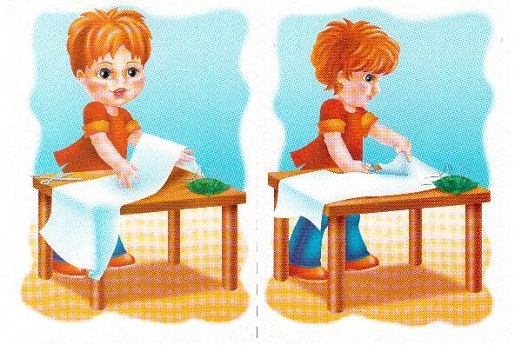
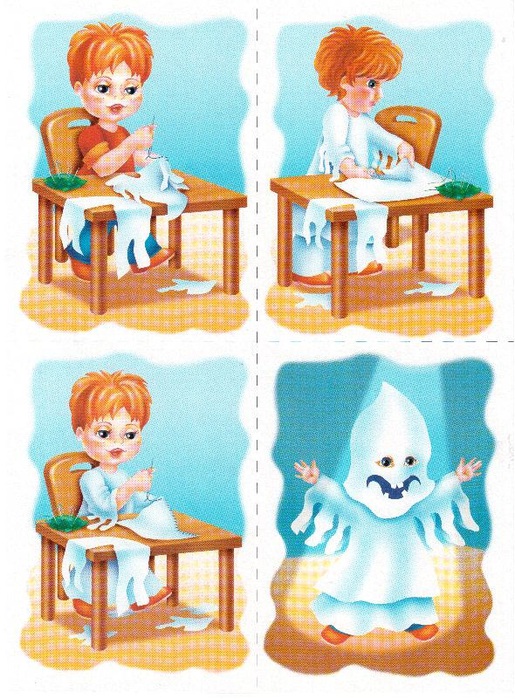
Lolita was invited to the carnival. She thought for a long time what kind of costume she should wear. Alina's friend brought Lolita a pattern for a ghost costume. Lolita wanted to act as a ghost at the carnival and she asked her mother to buy her white fabric, thread and needles for sewing. The girl laid out a white cloth on the table, took scissors and cut out the details of the costume. Then Lolita threaded a needle and began to sew a costume. When the costume was ready, Lolita put it on herself. From the remnants of the fabric, Lolita decided to sew a cap. The girl called her mother and friend Alina to try on the costume. Everyone liked the costume. AT good mood Lolita went to the children's carnival.
1. Answer the questions:
Where did they call Lolita?
What did Alina's friend bring to Lolita?
What did Lolita's mother buy for sewing a costume?
How did Lolita sew a ghost carnival costume? What did you do first and then what?
How did mom and friend Alina rate Lolita's costume?
In what mood did Lolita go to the carnival?
2. Retell the story.
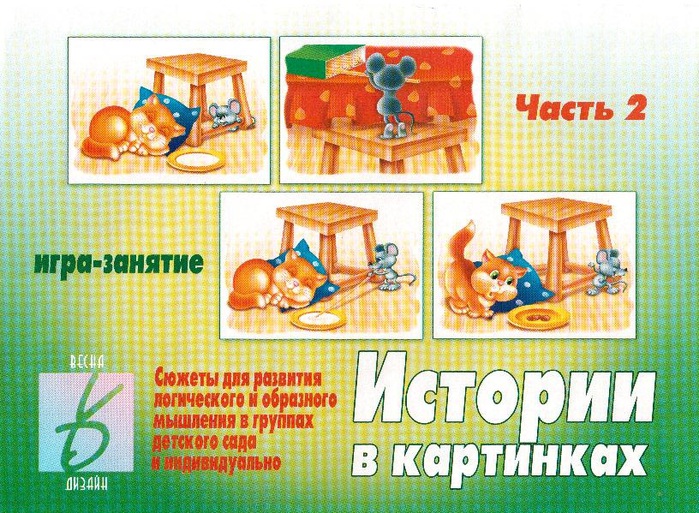
A series of plot pictures intended for independent compilation of stories by children.
Balloon.
An adult asks the child to arrange the plot pictures in a logical sequence, answer the questions with a full answer and compose a story on their own.

1. Answer the questions:
Who and where lost the balloon?
Who found the ball on the field?
What was the mouse and what was his name?
What did the mouse do on the field?
What did the mouse do with the ball?
How did the ball game end?
2. Compose a story.
Sample story "Balloon".
The girls were tearing cornflowers in the field and lost the balloon. Little mouse Mitka ran across the field. He was looking for sweet grains of oats, but instead he found a balloon in the grass. Mitka began to inflate the balloon. He blew and blew, and the ball got bigger and bigger until it turned into a huge red ball. A breeze blew, picked up Mitka with the balloon and carried him over the field.
Caterpillar house.

1. Answer the questions:
Who are we going to write about?
Tell me, what was the caterpillar and what was its name?
What did the caterpillar do in the summer?
Where did the caterpillar once crawl? What did you see there?
What did the caterpillar do to the apple?
Why did the caterpillar decide to stay in the apple?
What did the caterpillar make in her new home?
2. Compose a story.
Sample story "House for the caterpillar."
The story is not read to the child, but can be used as an aid in case of difficulties in compiling a children's, author's story.
Lived - lived a young, green caterpillar. Her name was Nastya. She lived well in the summer: she climbed trees, ate leaves, basked in the sun. But the caterpillar did not have a house and she dreamed of finding it. Once a caterpillar crawled up an apple tree. I saw a big red apple and started to nibble it. The apple was so delicious that the caterpillar did not notice how it gnawed right through it. The caterpillar Nastya decided to stay in the apple. She felt warm and comfortable there. Soon the caterpillar made a window and a door in its dwelling. Got a wonderful house
New Year's preparations.
An adult asks the child to arrange the plot pictures in a logical sequence, answer the questions with a complete answer and compose a story on their own.


1. Answer the questions:
What holiday was coming up?
Who do you think bought the tree and put it in the room?
Tell me what the tree was like.
Who came to decorate the Christmas tree? Think of names for the children.
How did the children decorate the Christmas tree?
Why was the ladder brought into the room?
What did the girl eat on top of her head?
Where did the children put the toy Santa Claus?
2. Compose a story.
Sample story "New Year's preparations."
The story is not read to the child, but can be used as an aid in case of difficulties in compiling a children's, author's story.
New Year's Eve was approaching. Dad bought a tall, fluffy, green Christmas tree and put it in the hall. Pavel and Lena decided to decorate the Christmas tree. Pavel took out a box with Christmas decorations. Children hung flags and colorful toys on the Christmas tree. Lena could not reach the top of the spruce and asked Pavel to bring a ladder. When Pavel installed a ladder near the spruce, Lena attached a golden star to the top of the spruce. While Lena was admiring the decorated Christmas tree, Pavel ran to the pantry and brought a box with a toy Santa Claus. The children put Santa Claus under the Christmas tree and ran away from the hall satisfied. Today, parents will take their children to the store to choose new costumes for the New Year's carnival.
Bad walk.
An adult asks the child to arrange the plot pictures in a logical sequence, answer the questions with a complete answer and compose a story on their own.


1. Answer the questions:
Name who you see in the picture. Come up with a name for the boy and a nickname for the dog.
Where the boy walked with his dog
What did the dog see and where did it run?
Who flew out of a bright flower?
What was the little bee doing in the flower?
Why did the bee bite the dog?
What happened to the dog after the bee sting?
Tell me how the boy helped his dog?
2. Compose a story.
Sample story "Unsuccessful walk".
The story is not read to the child, but can be used as an aid in case of difficulties in compiling a children's, author's story.
Stas and the dog Soyka were walking along the alley of the park. Jay saw a bright flower and ran to smell it. The dog touched the flower with its nose and it swayed. A small bee flew out of the flower. She collected sweet nectar. The bee got angry and bit the dog on the nose. The dog's nose was swollen, tears flowed from his eyes. Jay lowered her tail. Stas was worried. He took a band-aid out of his bag and stuck it over the dog's nose. The pain subsided. The dog licked Stas on the cheek and wagged its tail. Friends hurried home.
Like a mouse painting a fence.
An adult asks the child to arrange the plot pictures in a logical sequence, answer the questions with a complete answer and compose a story on their own.

1. Answer the questions:
Come up with a nickname for the mouse that you will talk about in the story.
What did the little mouse decide to do on the day off?
What did the mouse buy in the store?
Tell me what color was the paint in the buckets
What paint did the mouse paint the fence with?
With what color paints did the mouse draw flowers and leaves on the fence?
Think of a sequel to this story.
2. Compose a story.
A sample of the story "How the mouse painted the fence."
The story is not read to the child, but can be used as an aid in case of difficulties in compiling a children's, author's story.
On the day off, the little mouse Proshka decided to paint the fence near his house. In the morning Proshka went to the store and bought three buckets of paint from the store. I opened it and saw: in one bucket - red paint, in the other - orange, and in the third bucket - green paint. Mouse Prosha took a brush and began to paint the fence with orange paint. When the fence was painted, the mouse dipped a brush in red paint and painted flowers. Prosha painted leaves with green paint. When the work was done, friends came to visit the mouse to look at the new fence.
Duckling and chicken.
An adult asks the child to arrange the plot pictures in a logical sequence, answer the questions with a complete answer and compose a story on their own.


1. Answer the questions:
Come up with nicknames for the duckling and the chicken.
What time of year is shown in the pictures?
Where do you think the duckling and the chicken went?
Tell how friends crossed the river:
Why didn't the chicken go into the water?
How did the duckling help the chick swim to the other side?
How did this story end?
2. Compose a story.
Sample story "Duckling and chicken."
The story is not read to the child, but can be used as an aid in case of difficulties in compiling a children's, author's story.
On a summer day, the duckling Kuzya and the chicken Tsypa went to visit the turkey. The turkey lived with a turkey dad and a turkey mom on the other side of the river. Duckling Kuzya and chicken Tsypa came to the river. Kuzya plopped down into the water and swam. The chick did not go into the water. Chickens can't swim. Then the duckling Kuzya grabbed a green leaf of a water lily and put Chick on it. The chicken floated on a leaf, and the duckling pushed him from behind. Soon friends crossed to the other side and met with a turkey.
Successful fishing.
An adult asks the child to arrange the plot pictures in a logical sequence, answer the questions with a complete answer and compose a story on their own.

1. Answer the questions:
Who went fishing one summer? Come up with nicknames for the cat and dog.
What did your friends take with them?
Where did the friends settle down to fish?
What do you think the cat started screaming when he saw that the float went under the water?
Where did the cat throw the caught fish?
Why did the cat decide to steal the fish that the dog caught?
Tell me how the dog managed to catch the second fish.
Do you think the cat and the dog still go fishing together?
2. Compose a story.
Sample story "Successful fishing."
The story is not read to the child, but can be used as an aid in case of difficulties in compiling a children's, author's story.
One summer, Timothy the Cat and Polkan the dog went fishing. The cat took a bucket, and the dog took a fishing rod. They sat down on the bank of the river and began to fish. The float went under the water. Timofey began to shout loudly: "Fish, fish, pull, pull." Polkan pulled out the fish, and the cat threw it into the bucket. The dog threw the bait into the water a second time, but this time he caught an old boot. Seeing the boot, Timothy decided not to share the fish with Polkan. The cat quickly picked up the bucket and ran home for dinner. And Polkan poured water out of his boot, and there was another fish. Since then, the dog and the cat have not gone fishing together.
Resourceful mouse.
An adult asks the child to arrange the plot pictures in a logical sequence, answer the questions with a complete answer and compose a story on their own.

1. Answer the questions:
Come up with a name for the girl, nicknames for a cat, a mouse.
Tell me who lived in the girl's house.
What did the girl pour into the cat's bowl?
What did the cat do?
Where did the mouse run out and what did he see in the cat's bowl?
What did the little mouse do to drink milk?
What surprised the cat when she woke up?
Think of a continuation of this story.
2. Compose a story.
Sample story "Resourceful little mouse."
The story is not read to the child, but can be used as an aid in case of difficulties in compiling a children's, author's story.
Natasha poured milk into a bowl for the cat Cherry. The cat drank a little milk, put her ears on the pillow and fell asleep. At this time, the little mouse Tishka ran out from behind the closet. He looked around and saw milk in the cat's bowl. The mouse wanted milk. He climbed onto a chair and pulled a long macaroni out of the box. The little mouse Tishka quietly crept up to the bowl, put the macaroni in milk and drank it. Cherry the cat heard a noise, jumped up and saw an empty bowl. The cat was surprised, and the mouse ran back behind the closet.
How a crow grew peas.


An adult asks the child to arrange the plot pictures in a logical sequence, answer the questions with a complete answer and compose a story on their own.
1. Answer the questions:
What time of year do you think the cockerel walked across the field?
What did the cockerel bring home?
Who noticed the rooster?
What did the crow do to eat the peas?
Why didn't the crow eat all the peas?
How did the bird sow pea seeds in the ground?
What appeared from the earth after the rain?
When did pea pods appear on plants?
Why was the crow happy?
2. Compose a story.
A sample of the story "How a crow grew peas."
The story is not read to the child, but can be used as an aid in case of difficulties in compiling a children's, author's story.
In early spring, a cockerel walked across the field and carried a heavy sack of peas over his shoulders.
The cockerel noticed the raven. She jabbed her beak at the sack and tore off the patch. Peas fell out of the bag. The crow began to feast on sweet peas, and when she had eaten, she decided to grow her crop. With its paws, the bird trampled several peas into the ground. Rain is coming. Very soon, young shoots of peas appeared from the ground. In the middle of summer, tight pods with large peas inside appeared on the branches. The crow looked at her plants and rejoiced at the rich harvest of peas that she managed to grow.
Please note: The Ministry of Education and Science recommends in 2017/2018 academic year include educational events dedicated to the year of ecology in the programs of upbringing and socialization(2017 is declared the year of ecology and specially protected natural areas In Russian federation).
We recommend that teachers of grades 1-11 and educators of preschool educational institutions, together with the children, take part in international competition "Laws of Ecology" dedicated to the year of ecology. Participants of the competition will test their knowledge of the rules of behavior in nature, learn Interesting Facts about animals and plants listed in the Red Book of Russia. All students will be rewarded with colorful award materials, and teachers will receive free certificates on the preparation of participants and prize-winners of the international competition.
Teaching children a story from a picture and a series plot pictures.
Library
materials
Teaching children storytelling from a picture and a series of plot pictures
With formed connected speech essential condition child's success in school. Currently underway active work for the preparation state standards preschool education, the introduction of which will ensure the comprehensive harmonious development of preschoolers. One of major areas preschool work educational institution in accordance with GEF is speech development.
One of the most difficult types of speech activity is compiling stories based on the picture and a series of plot pictures.
Diagnostics of the ability to compose stories based on a picture and a series of plot pictures showed that some children have low level skills for this species speech activity (children find it difficult to establish connections, therefore they make meaningful and semantic errors in stories; when telling, they always require the help of an adult; they repeat the stories of their peers; vocabulary is poor). Other children in stories make logical errors, but they themselves correct them with the help of adults and peers; (Vocabulary is quite wide). And only a few children possess those skills that correspond to high level(the child is independent in inventing stories, does not repeat the stories of other children; has a sufficient vocabulary).
M. M. Konina highlights the following occupations on teaching children storytelling in a picture:
1) Drawing up a descriptive story based on a subject picture;
The description of subject pictures is a coherent, consistent description of the objects or animals depicted in the picture, their qualities, properties, and lifestyle actions.
2) Drawing up a descriptive story based on a plot picture;
The description of the plot picture is a description of the situation depicted in the picture, which does not go beyond the content of the picture. Most often, this is a statement of the type of contamination (both a description and a plot are given).
3) Inventing a narrative story based on a plot picture;
A narrative story based on a plot picture (conditional name), according to the definition of K. D. Ushinsky, "a story that is consistent in time." The child comes up with a beginning and an end to the episode depicted in the picture. He is required not only to comprehend the content of the picture and convey it in words, but also to create previous and subsequent events with the help of imagination.
4) Drawing up a story in sequence story series pictures;
A story based on a sequential plot series of paintings. In essence, the child talks about the content of each plot picture from the series, linking them into one story. Children learn to tell in a certain sequence, logically linking one event to another, master the structure of the narrative, which has a beginning, middle, end.
5) Drawing up a descriptive story based on a landscape painting and a still life.
Mood-inspired descriptions of landscape paintings and still lifes often include narrative elements. .
The meaning of the picture is didactic tool
preschool education
The principle of writing a story in any picture should be based on a fairly rich vocabulary, knowledge of the surrounding reality.
Children should:
Know what the story has beginning, middle and end; these parts are "friends" with each other;
Be able to distinguish between story and simple dialing offers.
Paintings and series of paintings can be divided into three types: 1) the action takes place outdoors; 2) the action takes place indoors; 3) landscape, without actors.
First kind of pictures: The action takes place outside. Start off the story can be from the words: once ..., once ..., was ... Next, you should answer the question: when? (season and name of the part of the day); if the event occurs: in autumn, day (morning, evening) - autumn, gloomy, cloudy, sunny, warm, cold, rainy, windy, clear; winter day (morning, evening) - winter, frosty, cold, clear, snowy; spring day (morning, evening) - spring, clear, sunny, warm; summer day (morning, evening) - hot, warm, summer, clear. Starting options may be different: “Once on a hot summer day ... Once on a winter morning ... It was warm autumn evening…» Next group questions: who conceived (decided) what? where (where)? Come up with a name for the hero, indicate the place of action, the goal. For example: "Petya went out into the yard with a typewriter ... The children went into the forest for mushrooms ...". middle story - a description of the immediate events that happened to the hero (heroes). Question: "What happened?" (Cause-and-effect relationships are established). End - the result of an action, an assessment of the actions of the heroes, a statement of attitude towards the hero. An adult may offer to continue the story - what could happen next. Second type of painting: The action takes place indoors. Start. We answer the questions: when? where? who thought (decided)? The time of the year falls, the name of the part of the day remains. When? - use expressions: one morning, afternoon, evening, after breakfast, lunch, walk, sleep ... Where? - at home, in the garden, in a group ... Who (given a name) decided, proposed, conceived what. Middle and end. They remain the same as in the work with the first type of paintings.
The third kind of pictures: there are no actors and events. These are pictures of the Early autumn», « Late fall", "Winter". Start. The title of the picture, the name of the author, the definition of the time of year. She came ... came ... (according to the painting by I. Levitan). Middle. Consistently, from top to bottom (from the state of the sky and the sun, we end with what is on the ground), taking into account the foreground and background, it is necessary to give a description of the signs of a given season. It is very useful during the examination to use: - works of poets and writers that talk about the seasons, draw the attention of children, how the author speaks about the sky, snow, sun, other objects of nature, and try to use these words in the story; - the experience of observing nature on walks. All this contributes to the accumulation and enrichment active dictionary child, facilitates the process of compiling a story. End. Transmission of the mood of the author and the child. Questions: “What mood do you have when you look at this picture? Why?" We must not forget about the use of words with a diminutive meaning (grass, birch, sun, stream), words with opposite meaning(far-close, high-low, thick-thin, wide-narrow).
sample dictionary
Sky
In autumn: gloomy, overcast, cloudy, clear, dark…
In winter: gray, low, clear, overcast...
The sun
In autumn: it shines, hides behind the clouds, sometimes peeks out from behind the clouds ...
In winter: not warm at all ...
day, air
In autumn: autumn, cloudy, bright, clear, rainy, sunny, warm ...
In winter: frosty, wintry, fresh, cold…
Rain
In autumn: drizzling, drizzling, downpour, small, mushroom ...
Trees,
bushes
In autumn: with leaves, without leaves, leaf fall, yellow, red, green, crimson, multi-colored, leaves fall, swirl ...
Flowers,
herbs
In autumn: wilted, withered, turned yellow ...
Earth
In autumn: dirty after rain, puddles, covered with multi-colored or gold carpet
Snow, ice
In winter: fluffy, light, sticky, silver, sparkles in the sun, sparkles, glitters, thin, thick, transparent, cold, smooth ...
Sample Structure for a Storytelling Lesson
Lesson stage
Lesson time for groups, min
second junior
medium-
nya
senior
prepare-
body
for school
1
1
2
2
Articulation gymnastics, respiratory and (or) voice exercises. Formation sound culture speeches
3
3
4
4
Presentation of the topic of the lesson: looking at a picture or a toy. Conversation (children's answers to teacher's questions). If this is a series of pictures, analyze the actions for each picture separately
4
5
5
6
Physical education minute
3
3
4
4
Compilation of sentences with appropriate vocabulary work
3
4
5
Writing your own story
4
5
6
8
Total
15
20
25
30
Types of classes for the development of speech:
retelling;
a story based on a plot picture or a painting by a famous artist;
a story based on a series of plot pictures;
descriptive story by subject;
dramatization;
creative story. There are three types of texts: narrative, descriptive, descriptive-narrative.
The retelling could be: consistent, complete (detailed); selective, concise, creative.
In addition to retelling, the teacher teaches children the ability to compose stories.
Types of stories:
by a series of subject pictures in action;
series of plot pictures;
plot picture based on a plan (scheme).
In the first junior group training in the classroom is aimed at improving children's ability to understand the teacher's speech, respond to the simplest and more difficult questions keeping up the conversation.
The questions of the teacher are the leading method of activating the speech and thinking of the child. When examining objects, observing phenomena, children correctly name separate actions, but they cannot establish their relationship and sequence, i.e. find it difficult to imagine the situation as a whole.
RED CAT DRINKING MILK.
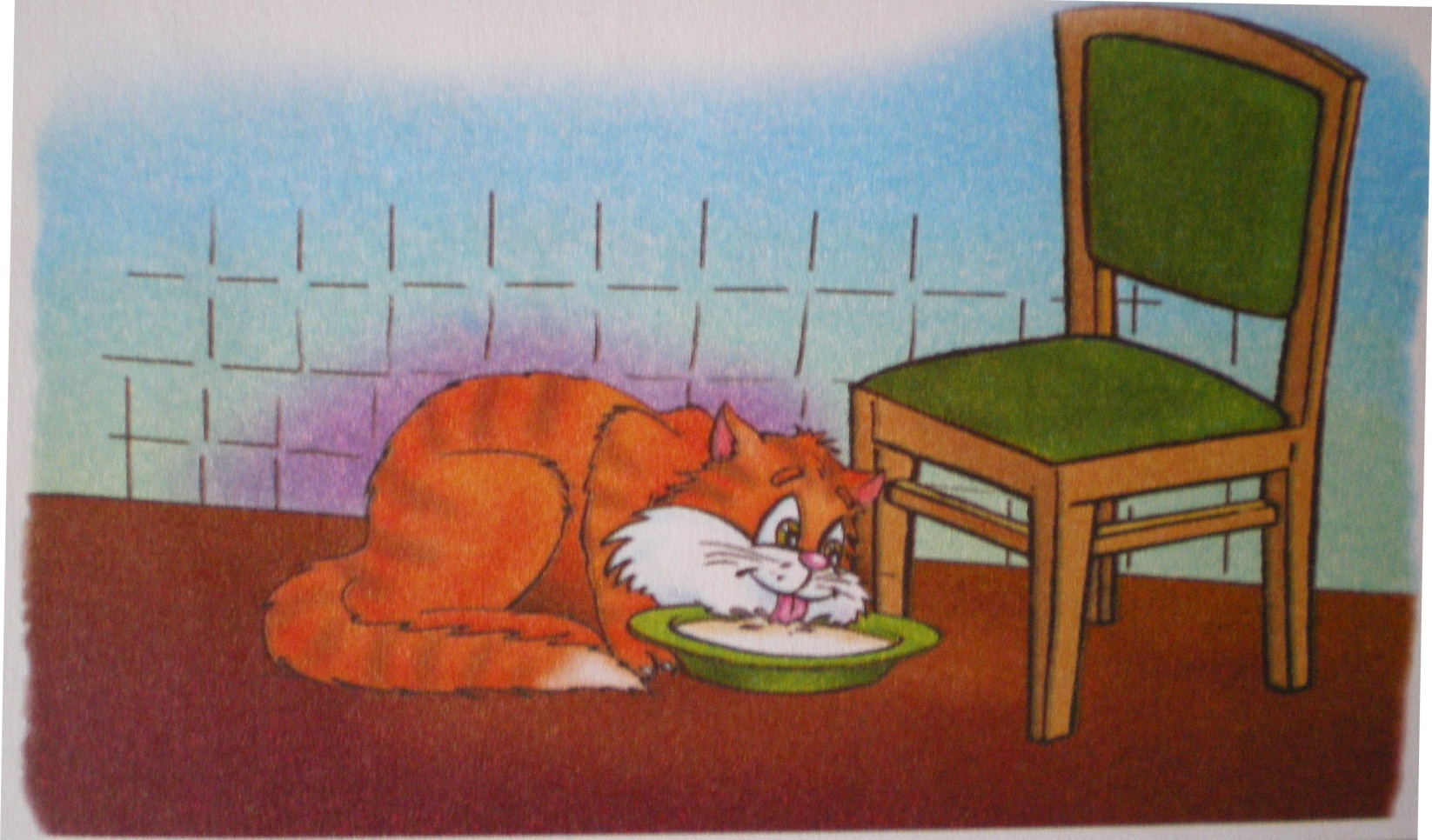
■ Who drinks milk?
■ What color is the cat?
■ What does the red cat drink?
■ Where is the milk in the bowl from?

■ Who sang in the yard in the morning?
■ When did the cockerel crow?
■ Where did the cockerel crow?
■ Why did the cockerel crow?
In the second junior group the preparatory stage of teaching storytelling in the picture is carried out. Children of this age cannot yet give an independent coherent presentation. Their speech is in the nature of a dialogue with the teacher. Children are limited to listing objects, their individual properties and actions, which is explained by little experience in perception, a small vocabulary, and insufficient ability to build a sentence.
The main tasks of the educator in the work on the picture are as follows: 1) teaching children to look at a picture, developing the ability to notice the most important thing in it;
2) a gradual transition from classes of a nomenclature nature, when children list the depicted objects, objects, to classes that exercise in coherent speech (answering questions and compiling short stories).
Classes to familiarize children with paintings can be carried out in a variety of ways. The lesson usually includes two parts: examining the picture on questions, the final story-example of the teacher. It may begin with a short introductory conversation.
Its purpose is to find out the ideas and knowledge of children about the depicted, to call emotional mood before seeing the picture. Questions of the educator are the main methodological technique, which necessitates their thoughtful and appropriate selection.
Questions addressed to children should be easy to understand, and the answers to them should not cause difficulties. Their sequence should ensure the integrity of perception, so the questions are far from always appropriate: what is it? What is there? What else is drawn? Here sample questions based on the painting "Cat with kittens": who is depicted in the picture? What does a red kitten do? What is the mother cat? What she does? Sometimes the question is not enough for the child to accurately characterize the quality, the action. Then clarification, advice, hint of the teacher are needed. He ensures that children correctly correlate words with objects, their qualities and properties, speak in extended sentences.
Children learn to describe pictures in sentences of two or three words. Looking at a picture is used to develop accuracy and clarity of speech. The teacher makes sure that the children name the objects and actions correctly in accordance with those depicted in the picture. With an example of his speech, questions and instructions, he helps to find words that most accurately define the properties and qualities of objects.
Examination of pictures is always accompanied by the word of the educator (questions, explanations, story). Therefore, special requirements are imposed on his speech: it must be clear, concise, clear, expressive. The generalizing statements of the teacher are a model for answering a question, a model for constructing a sentence.
After the conversation, the teacher himself talks about what is drawn in the picture. Sometimes you can also use work of fiction(for example, stories of writers about pets). Can be read little poem or a nursery rhyme (for example, “Cockerel, cockerel, golden comb” or “Kisonka-murysenka”, etc.). You can make a riddle about a pet (for example: “Soft paws, and in the paws of a scratch-scratch” - after the picture “Cat with kittens”; “It barks loudly, but does not let it into the house” - after the picture “Dog with puppies”; “Golden scallop, butter head, gets up early in the morning, sings loudly" - after the picture "Chickens", etc.). You can sing with the children a song they know about a cat, a dog, a chicken. In the younger group, it is especially important to use a variety of game techniques.
M. M. Konina offers, for example, such: “Let's tell the doll”, “What will we tell the dog”. With the help of a teacher, children are happy to talk about a picture of a doll that came to visit them, a cat, etc. You can also offer to choose an object of description (“Choose a puppy for yourself and tell about it” - based on the picture “Dog with puppies”).
If the picture correctly reflects the signs of a pet, the teacher can connect its examination with the display of a toy (“The same kitten, cockerel; similar puppy, chicken”). This can be done in the form of a dramatization (a doll, a cat, a dog come to visit the children and talk to them). The teacher asks the children questions that consolidate their knowledge about this animal. This technique emotionally switches their attention, encourages new statements.
Sometimes you can, as it were, put the child in the place of the one who is drawn (“As if we are walking. As if this is our kitten”). The following can be distinguished characteristics painting classes with younger children preschool age:
a) alternation of choral and individual responses;
b) the obligatory presence of emotional and game techniques;
c) the use of literary and artistic inserts.
First paintings for children junior group are paintings depicting individual items(a toy or familiar household items), pets, simple stories from a child's life (Our Tanya series). After class, the painting remains in the group for several days. Children will look at it again, notice what they did not notice before, and begin to speak out. The educator directs this examination, clarifies the statements of the children, encouraging and supporting them.
Examination of the painting "Chicken and chickens" 
educational goals. Ensuring a holistic perception of the picture.
development goals. Raise speech activity children, the formation of the ability to answer questions about the picture, the improvement of the grammatical structure of speech, the clarification and expansion of the vocabulary on the topic "Poultry", development creative imagination.
educational goals. education of love and careful attitude to all living things.
Preliminary work. Observation of the habits of birds during a walk, looking at an album with pictures from the cycle "Domestic and Wild Birds", guessing riddles, learning the outdoor game "Hatch and Chicks".
Lesson progress
1. Organizational moment. Didactic game"Who came to us." The teacher shows a toy (or picture) depicting a duck, turkey, duck, rooster, goose and suggests remembering how they cast their votes.
2. Examining the picture and talking about it. “Now look at the picture. Who do you see on it? What is another name for this chicken? ( mother hen, slut) Why is it called that? Do you know how chickens are born? Tell. Is a chicken a bird or not? Can a chicken fly? Is the chicken domestic or wild? Why? - How many chickens does the mother hen have? ( lot) What does a chicken eat? - What other birds do you know? - Continue: the chicken has chickens, the duck has ..., the turkey has ..., the goose has .... What is the difference between chickens and hens? - What do they have in common? - Chicken-mother, kids-chickens. Can we say that this is a bird family? - Who is missing here? - Who is dad? What time of year does this happen? Why do you think so? - Where do chickens and chickens walk? Are they walking calmly or are they alarmed? - What are they afraid of? - What is the name of this weather? - What sky? ( thunderstorm)- What color are the clouds? - Is the wind blowing? What else is visible in the sky? (lightning). What does a hen call her chicks? (ko-ko-ko) How do chickens squeal? (wee-wee-wee)- And how does the rooster crow? (ku-ka-re-ku!)- What grows in the meadow? - How many daisies are there? (lot). 3. D / and "One - many" One chicken - many chickens, one chicken - ..., one feather - ..., one stone - ..., one berry - ..., one flower - .... 4. D / and “Call it affectionately” Chicken - ..., chicken - ..., rooster - ..., flower - .... cloud - ..., sun - ..., grass - ... .
5. Riddles
Above me, above you
A bag of water floated by.
Ran into a distant forest
Lost weight and disappeared. (Cloud)
The mother has many children.
All children are the same age.
(Hen with chickens)
Appeared in a yellow coat:
Farewell, two shells! (Chick)
Kvokhchet, kohchet,
Calls the children
He gathers everyone under the wing. ( Hen)
Fluffy cotton wool floats somewhere.
The lower the wool, the closer the rain. ( Cloud)
6. Clean tongues
Chicken and hen drink tea on the street.
Crested laughers laughed with laughter: - Ha - ha - ha - ha - ha!
7. sayings
Without a uterus, children will also disappear.
The whole family is together, and the soul is in place.
A chicken pecks grain by grain - it lives to its fullest.
8. The story of the teacher in the picture.
The hot summer has come. A hen and chickens were walking on a green meadow.
They nibbled grass-ant. Looking for little worms.
But suddenly he blew strong wind. A black cloud appeared. Lightning flashed. The hen called her chickens and they ran home as soon as possible.
9. D / and "Fold the picture"

10. Evaluation of the work of children. Summing up the lesson.
AT middle group it is already becoming possible to lead children to compose a small coherent narrative, since at this age speech improves, speech and mental activity increases. First, the children talk about the questions of the teacher. This may be a collective story of children or a joint story of a teacher and one child. At the end of the lesson, as if summing up all the statements, the teacher gives his story. Then you can move on to storytelling. Consequently, when teaching storytelling from a picture in the middle group, the leading technique is the sample.
In the middle group, a sample is given for copying. “Tell me how I am”, “Well done, I remember how I told you,” the teacher says, that is, at this age there is no need to deviate from the model. The sample story must answer certain requirements(reflect specific content, be interesting, short, complete, be stated clearly, vividly, emotionally, expressively). Here is an example of a teacher’s story based on the painting “Cat with Kittens”: “This picture is about a cat with kittens. The cat lies on the rug and looks after her kittens. Three kittens in a cat. A ginger kitten plays with a ball of thread, a gray kitten licks from a saucer, and the third, mottled kitten curled up and sleeps next to his mother.
At the end of the year, if the children have learned to tell according to the model, you can gradually complicate the task, leading them to independent storytelling. So, the teacher can give a sample story in one picture, and the children tell in another (for example, pictures from the series “Our Tanya” are used), “We are playing” (by E.G. Baturina), as well as some pictures from the series “ Pets ”(author S. Veretennikova): “Tanya is not afraid of frost”, “Whose boat?”, “Playing train”, “Dog with puppies” (“A black dog has two puppies. One lies near the dog, and the other stands near a dog.), etc. Children master the ability to compose according to a picture quite easily. By the end of the year, their stories may consist of 8-10 sentences and differ in the sequence of presentation.
Middle preschool age children can be led to compose stories, mainly descriptive ones, according to subject or plot pictures. The teacher strives to ensure that children use their vocabulary more widely, use participles, definitions, circumstances and different types of sentences.
Drawing up a story based on the picture "The work of the driver is difficult and complex"
educational goals. Improving the ability to answer questions about the picture, compose a story based on its fragment. Improving the skill of using wax crayons, the ability to paint over an image in one direction.
development goals. Development of coherent speech, visual attention and perception, coordination of speech with movement, general speech skills.
educational goals. Fostering collaborative skills in the classroom.
Equipment. The painting "The work of the driver is difficult and complex", the game "Modes of transport", a rubber ball, wax crayons, album sheets with an underdrawn image of a bus, a card with superimposed images of a bus and a truck. Preliminary work. Conducting a role-playing game "In the bus". Learning the game "Driver".

Lesson progress
1. Organizational moment. Game "Modes of transport"- What do you see in this picture? ( We see different cars)- What do the machines do? ( Cars are driving on the highway. - Who drives the cars? ( drivers).
Funny tires rustle along the roads, Cars, cars rush along the roads ... And in the back - important, urgent goods: Cement and iron, raisins and watermelons. The work of drivers is difficult and complicated, But how people everywhere need it.
2. Today we will consider the picture “The work of the driver is difficult and complex” and make up a story based on it.- Who do you see in the picture? (We see children) - What are they doing? (They are playing the game "On the bus") - Tell what each of the children is doing.
■ Ahead, a boy is sitting on a chair - the “chauffeur”. He has a steering wheel in his hands and a big blue cap on his head. He turns the steering wheel and announces stops. ■ There are two rows of chairs behind the “chauffeur” boy. Children are sitting on them - “passengers”. On the left is a girl in a yellow dress. She is holding a big bear in denim overalls and a cap. This is probably her son. Behind the girl sits a boy with a large briefcase. He's on his way to work.
■ On the right is a girl in a pink dress. She is holding a large doll in her hands. This is her daughter.
■ A girl is walking along the aisle between the chairs - the “conductor”. The girl has a blue dress. She has a red bag on her shoulder. She hands the ticket to the girl in the orange dress.
Who else do you see in the picture?
■ We see the teacher and several boys and girls - bus passengers. The teacher sits on a chair by the window and watches the children play. Sometimes the teacher gives them advice on how to continue the game correctly.
Do you think kids like this game?
■ Yes, I like it very much. They have happy faces. They are interested in playing.
You spoke very well about the children depicted in the picture. Now tell us about the room in which they are located. What is it?
■ Children have a large, light, solar group. The group has large windows. There are flowers on the windows.
Very well. You are observant and attentive. Now let's play.
3. mobile game "Driver". Coordination of speech with movement.
I'm flying, I'm flying
At full speed
I am the driver
I myself am the motor.
(Run in a circle and turn an imaginary steering wheel).
I press the pedal
And the car rushes off into the distance.
(They stop, press the imaginary pedal with their right foot and run in the opposite direction.)
4. Exercise with the ball "What is he doing?"
Now I will throw the ball to you and name the profession, and you will catch the balls and say what the representative of this profession does. Chauffeur…
■ … drives a car, turns the steering wheel, honks.
Driver…
■ … drives a tram, announces stops, presses the bell.
The game continues until all the children answer once. Then the teacher removes the ball and invites the children to the tables.
5. Drawing up a story based on the picture in parts.
Let's try to compose a story based on the picture "The work of the driver is difficult and complex." I will start and you will continue the story. Katya will tell about the "chauffeur" boy. Misha is about the passengers, Arisha is about the “conductor” girl, and Masha will finish the story (composing the story in parts by the children).
6. The game "What has changed?"
You have already seen this game today. Consider again the cars that drive on the highway. Then you close your eyes, and I will change something on the playing field. You will open your eyes and tell what has changed. (An airplane appeared in the sky. A ship appeared in the sea. A truck and a car changed places. A motorcycle disappeared from the highway.)
The game is played until all the children answer once. Then the teacher removes the game.
7. Exercise "What is missing?"
The teacher invites the children to the tables, on which album sheets with an unfinished bus and wax crayons have already been prepared. on the typesetting canvas there is a subject picture with the image of a bus.
What did you draw?
■ Two wheels, steering wheel, door, headlights.
Now color the bus. Try to paint every detail in one direction.
The children are doing the task. The teacher collects the works, lays them out on one table and organizes their discussion.
8. Exercise "Who is attentive?"
The children are back at the tables. The teacher gives them cards with superimposed images of a bus and a truck.
And now the task of attentiveness. What do you see on the card?
■ It's a bus and a truck.
Circle the image of the bus with your finger.
The children are doing the task.
Now circle the image of the truck.
The children are doing the task. The teacher evaluates their work and removes the cards.
The story of the painting "The work of the driver is difficult and complex"
We see in the picture the children who organized the game "On the Bus". Children play in a large and bright group room. They put chairs in rows, put on costumes, took toys.
Ahead, a boy is sitting on a chair - the “chauffeur”. He has a steering wheel in his hands, a large cap on his head. The boy turns the steering wheel and announces stops.
There are two rows of chairs behind the “chauffeur” boy. Children are sitting on them - “passengers”. On the left we see a girl in a yellow dress. She is holding a bear. This is probably her son. Behind the girl sits a boy with a large briefcase. He's on his way to work. The girl in the pink dress, pictured on the right, is holding a large doll in her arms. Probably, the girl is taking her to kindergarten.
A “conductor” girl is walking along the aisle between the chairs. The girl is wearing a blue dress. She has a red bag on her shoulder. The girl holds out a ticket to a passenger in an orange dress. There are other "passengers" on the bus.
The teacher sits at the window and looks at the children with a smile. Sometimes the teacher helps the children with advice.
Children themselves came up with a game and assigned roles. They really like to play together.
10. End of class. Evaluation of work.
The teacher invites the children to remember what they did in the lesson, what they were interested in doing. Then the teacher evaluates the activity of each child.
At senior preschool age due to the fact that the activity of children is increasing, their speech is improving, there are opportunities for independent compilation of stories based on different pictures. In the classroom using the picture, various different tasks, depending on the content of the picture:
1) to teach children to correctly understand the content of the picture;
2) educate feelings (specifically planned depending on the plot of the picture): love for nature, respect for this profession, etc .;
3) learn to compose a coherent story based on a picture;
4) activate and expand vocabulary (specifically, new words are planned that children need to remember, or words that need to be clarified and consolidated).
AT senior group The role of the educator in the learning process is already changing. From a direct participant, he becomes, as it were, an observer, intervening only when necessary. Great demands are placed on the stories of older preschool children: accurate transmission of the plot, independence, imagery, expediency of using language tools(the exact designation of actions, qualities, states, etc.).
The child's awareness of the task is necessary condition its correct execution. At the same time, the leading role of the educator is very large - he helps to understand and correctly complete the task: “You were told“ tell ”, and you said one word”; “We need to figure out what happened next. Come up with it yourself, because it is not drawn in the picture.
The story-model of the teacher offered to children in the senior and especially in preparatory group, serves as a means to transfer them to a higher level of development of the ability to tell. The educator requires not a simple reproduction of the sample, but a generalized imitation of it. Literary samples are used. The sample most often concerns a part of the picture, the most difficult, less bright, and therefore not noticeable to children. This gives them the opportunity to speak out about the rest.
Compilation of the story "Puppy" based on a series of story paintings
Goals:
educational: teach children how to plan a story, by highlighting main idea in each picture; to teach how to compose a story in accordance with the plan; developing: develop a vocabulary of adjectives; develop mental activity and memory in children; educational: develop a sense of compassion. Equipment: a series of plot paintings "Puppy", toys - a puppy and an adult dog. Preliminary work: games on the topic "Pets", drawing a puppy and an adult dog.
Lesson progress
1. Organizing time. Game "Everyone Lives Somewhere"
Everyone lives somewhere
Fish in the river right hand draw waves in the air
In a mink - a mole, (squat)
Hare - in the field, (jump, making ears with their hands)
Mouse - in the straw, (squat)
I am in a big brick house, (they close their hands above their heads, depicting a roof)
Dog Volchok - in my yard, in a wooden kennel, (get on all fours)
Cat Murka - on the couch, ("washed" behind the ear)
Zebras - in Africa, in the savannah, (run in a circle with a wide step)
In the dark jungle - a hippopotamus, (they go to the wreck)
Well, where does the sun live? (shrugs)
Day and morning - it's clear:
in the sky the sun is beautiful to live. (stretch arms up, standing on toes)
2. Announcement of the topic. Today we will make up a picture story, but before that, I want you to compare these two toy dogs. Together with the teacher, the children compare the puppy and the adult dog, highlighting the same and features: pets, a large dog - a small puppy, a strong dog - a weak puppy, etc.
Picture Series Conversation
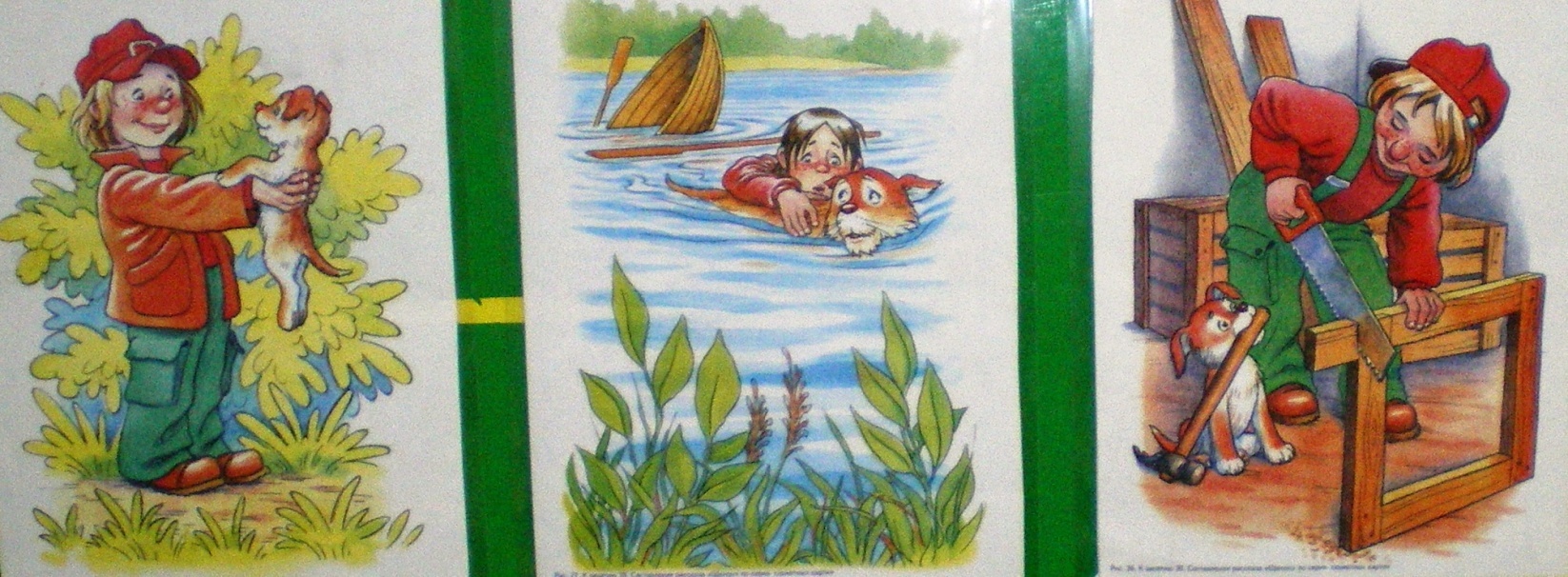
Where was the boy going? - Give the boy a name. - Who met on his way? What decision did the boy make? Why did the boy decide to adopt a puppy? - What did Vasya call his puppy? - How did the boy take care of the puppy? - How did the puppy become? - What can you say about the season in the first, second and third pictures? - What happened one summer?
3. Making a story plan.
The teacher asks the children to make one sentence for each picture. Thus, the children gradually plan the story.
Sample Plan
1. The boy finds a puppy. 2. Taking care of the puppy. 3. Rex comes to the rescue.
4. Fizminutka. Two puppies cheek to cheek (fold hands with palms to each other; to the right, and then Pinch the brush in the corner left cheek) And the brush of the sexual stick is above the head (raise your hands up and connect over your head) Stick - click puppies from the shoulder, (clap on shoulders) The two puppies left the food. (walk around your chair and sit on it).
5. Children's stories.
Puppy
Once Vasya went out for a walk. Suddenly he heard someone whimpering. It turned out that it was a small defenseless puppy. Vasya liked the puppy very much, and he decided to take him home. At home, he looked after him and built a booth for the puppy. Soon the puppy grew up and became big and strong. Vasya decided to take Rex for a boat ride. He asked his brother for a boat. And the brother forgot that there was a small gap in the boat. When Vasya and Rex swam to the middle of the river, the boat began to fill with water. Vasya did not know how to swim. He began to sink. Rex swam up to the owner and helped him get ashore.
6. Color the drawing so that the dog is in front of (or behind) the kennel.

7. The result of the lesson. The teacher sums up and evaluates the children's stories.
In the classroom in the preparatory group for school a sample teacher should be offered only if the children do not have the ability to coherently present the content of the picture. In such classes, it is better to give a plan, suggest a possible plot and sequence of the story. In groups of senior preschool age, all types of stories based on a picture are used: a descriptive story based on subject and plot pictures, a narrative story, a descriptive story based on a landscape painting and a still life.
You can widely use a story based on a series of pictures (for example, on the topic “Our site in winter and summer”), where you no longer need a simple enumeration of ongoing events, but a sequential story with a beginning, climax and denouement. The conversation on questions preceding the story concerns the main points, the key points of the depicted plot.
The following techniques help to improve the ability to tell through a series of pictures: compiling a collective story - the teacher makes the beginning, the children finish; one child starts, another continues.
In the preparatory group children for the first time are led to the compilation of narrative stories. So, they come up with a beginning or an end to the plot depicted in the pictures: “That’s how I rode!”, “Where did you go?”, “Gifts for mom by March 8”, “The ball flew away”, “Cat with kittens”, etc. A well-defined task encourages creative fulfillment of it.
It is very important to teach children not only to see what is shown in the picture, but also to imagine previous and subsequent events. For example, according to the indicated pictures, the teacher can ask next questions: What did the guys say to the boy? ("That's how I rode!"); How did the children prepare gifts for their mother? ("March 8"); who put the basket here and what happened? ("Cat with kittens"). Several questions can be asked, as if to outline the storyline of the narrative story: where did these children come from? What happened to them next? How did these children continue to be friends? ("Waiting for guests").
The same picture can be used several times during the year, but different tasks should be set, gradually complicating them. When the children have mastered the skills of free storytelling, you can offer them two or more pictures (already seen and even new ones) and set the task - to come up with a story based on any picture. This will give them the opportunity to choose the content that is most interesting to them, and for those who find it difficult, an already familiar plot, according to which it is easy to compose a story. Such activities develop independence and activity, bring up a sense of self-confidence.
In the senior and preparatory groups, work continues on developing the ability to characterize the most essential in the picture. The highlighting of the essential most clearly appears in the selection of the name of the picture, so the children are given tasks such as “What did the artist call this picture?”, “Let's come up with a name”, “What can we call this picture?”.
Along with highlighting and characterizing the most essential, one must learn to notice details, convey the background, landscape, weather conditions, etc.
The teacher teaches children to introduce small descriptions of nature into their stories. Great importance while having such methodical technique- analysis of the teacher's story. Children are asked questions: “How did I start my story?”, “How does my story differ from Alyosha’s story?”, “How did I tell about the season depicted in the picture?”
Gradually, older preschoolers learn to supplement their stories in the picture with a description of the depicted landscape, weather conditions, etc. Here, for example, is the beginning of Marina’s story (6 years old) based on the painting “That’s how I rode!”: “Winter is painted in this picture. The day is sunny and cold. And the sky is colorful. It is from the sun that it shines so ... "
The introduction of such short descriptions to the story based on the picture gradually prepares the children for compiling stories based on landscape paintings and still life. This type of storytelling is used in the preparatory school group.
Drawing up a story based on the painting "Winter Forest"

educational goals. Generalization of ideas about winter. Updating the dictionary on the topic "Winter". Improving the skill of looking at a picture, forming holistic view about what is shown on it. Improving the skill of retelling.
development goals. The development of coherent speech, speech hearing, thinking, all types of perception, creative imagination, fine motor skills.
educational goals. Education of an emotional response to what is depicted in the picture, initiative, independence, creative imagination.
Equipment. Tape recorder, cassette with a recording of P. Tchaikovsky's play " Winter morning”, a picture by I. Grabar “Luxurious hoarfrost”, a story by D. Zuev “Winter Forest”, a mnemonic table for the story.
Preliminary work. Observation of winter changes in nature on a walk: how the color of snow changes depending on the light. A conversation about the sensations that arise during a winter walk. Learning poems by A. Pushkin, F. Tyutchev, A. Fet, S. Yesenin. Learning the game "Bear". Listening and discussion at the musical lesson of P. Tchaikovsky's play "Winter Morning". Preparation of the collective work "Branches in hoarfrost" in joint activities.
Lesson progress
1. Organizing time. Game "Sensitive hands"
What a miracle - miracles:
One hand and two hand!
Here is the left hand
Here is the right hand.
And I'll tell you, not melting:
Everyone needs hands, friends.
Strong arms won't rush into a fight
Kind hands stroke the dog
Smart hands can heal
Sensitive hands know how to make friends.
Now firmly hold hands, feel the warmth of the hands of your neighbors.
Listening to an excerpt from P. Tchaikovsky's play "Winter Morning". Creation emotional background lessons.
2. Topic message.
Today we will talk about winter. You tell me everything you know about this time of year. We will look at the painting by I. Grabar "Luxurious frost", we will retell the story "Winter Forest".
And now tell us about your mood when you heard P. Tchaikovsky's play "Winter Morning", saw I. Grabar's painting and a bouquet of "snowy" branches. ( Children talk about their mood.
3. Narration of poems by Russian poets.
Here is the north catching up clouds,
He breathed, howled - and here she is
The magical winter is coming.
Came, crumbled, in tufts
Hung on the branches of oaks;
She lay down with wavy carpets
Among the fields, around the hills;
A shore with a motionless river
Leveled with a plump veil;
Frost flashed. And we are glad
I'll tell mother winter's leprosy.
(A. Pushkin)
Enchantress Winter
Bewitched, the forest stands -
And under the snowy fringe,
Motionless, dumb
He shines with a wonderful life. (F. Tyutchev)
4. Examination of the painting by I. Grabar “Luxurious frost”.
What did the artist depict in the painting, which he called "Luxury Hoarfrost"? Try to describe the trees, the earth, the sky. (The artist painted a winter birch forest; trees covered with fluffy hoarfrost. There is snow on the ground in the forest. The sky is clear and high. It can be seen that this is a frosty day.
What tones prevail in the picture and why? (The picture is painted in light colors. Here and white, and blue, and pink, and lilac.
We observed that snow is never pure white. Its color depends on the lighting. On the walk, we have repeatedly seen how the color of the snow changes. Tell us about the snow we saw. (In the morning, on a walk, we saw silvery snow on which blue shadows lay. In the afternoon, from the window, we watched golden snow lit by the bright sun. In the evening, under the rays of the setting sun, the snow seemed pink. And when we go home in the dark, it seems blue).
Right. That is why the snow and frost in the painting by Igor Grabar are not white. Shades of all colors play on them: blue, pink, lilac. What other words can describe the snow and frost in the picture? What snow? (Loose, deep, soft, cold).
And what is frost? (fluffy, hairy, needle, cold).
What can you say about the birch trees shown in the picture? (smart, festive, hoarfrost, shaggy, lacy).
What is your mood when looking at this picture? (joyful, nice to look at the picture).
5. Reading the story of D. Zuev "Winter Forest".
Winter forest
A blizzard raged - and the forest was magically transformed. Everything is quiet. There is a silent knight in coniferous chain mail, enchanted by the spell of winter. The titmouse will sit down, but the branch will not flinch.
In the clearing, tiny Christmas trees flaunt apart. They got completely carried away. How good they are now, how pretty!
The blizzard silvered the magnificent hairstyle of slender pines. Below - not a knot, and on top - a lush snow cap.
A clear birch has spread its light braids of branches covered with hoarfrost, delicate pink birch bark glistens in the sun.
Trees covered with snow lace are numb in winter sleep. Deep winter sleep of nature. Snow sparkles, sparks flash and sparkles go out. Good forest in winter dress!
6. Physical culture pause "Bear"
Like on a hill - snow, snow. ( Children stand facing in a circle, in the center lies a "bear". Children slowly raise their hands up)
And under the hill - snow, snow. (slowly squat down, lower their hands)
And on the Christmas tree - snow, snow. ( They stand up again and raise their hands.)
And under the tree - snow, snow. (squat and lower their hands).
A bear sleeps under the snow.
Hush, hush... Don't make noise!
7.
Conversation on the text of the story using a mnemonic table. 
A mnemonic table is placed on the board next to the picture.
Let's talk about what you just heard. The diagrams will help you answer my questions.
Where does the story begin? How did it become in the forest after the blizzard? (children's answers)
What does "transformed" mean? How do you understand this word?
How are tiny Christmas trees described in the story?
What does it mean that Christmas trees stand alone? How do you understand this word?
What trees are you talking about? What hairstyles do pines have? What do they have on their heads?
How is the birch tree described in the story, the light braids of its branches, its thin bark?
How is the deep sleep of winter nature described in the story?
How does the story end?
Well done! You answered my questions perfectly. Now listen to the story again, because you will be retelling it. Look carefully at the diagram.
8. Rereading the story.
9. Retelling the story by children using a mnemonic table as a visual support. (Two children retell, then invite other children to retell).
10. End of class. evaluation of children's work.
The main thing to strive for when developing a series of classes and organizing work on them is to teach children new speech forms, to contribute to the formation of standards, samples, rules for this activity. It will be easier for the child to express his thoughts and in Everyday life, and when studying at school, if he is specially trained in this in an entertaining, interesting form under the guidance of an adult. Therefore, classes should be designed to create interest in the lesson from its very first minutes and maintain interest throughout it. This is the key to the successful outcome of the activities of all its participants.
For example, in a storytelling lesson based on a painting "Cat with Kittens" the teacher tells the children that today they will learn to compose a story from a picture. But what animal they will talk about, they will only know when each of them guesses his riddle about this animal and quickly draws a riddle. Riddles are guessed in each child's ear.
Sharp claws, soft pillows;
Fluffy fur, long mustache;
Purrs, laps milk;
Washes his tongue, hides his nose when it's cold;
Sees well in the dark;
She has good hearing, walks inaudibly;
Knows how to arch his back, scratches.
As a result, all children in the drawings get an image of a cat. Children are very interested in such a beginning, so they are easily, with interest, included in the work of examining the picture and compiling stories on it.
"Teddy bear on a walk" the teacher also reports that the children will learn to make up a story from the pictures. But who will become the heroes of the story, the children will find out when they guess the mini-crossword puzzle. It consists in the fact that children need to guess the words on the cards by selecting letters. The result is the words: teddy bear, hedgehog, bee, forest. Children perform the task with interest, because they were intrigued, it was interesting for them to cope with such a task. Next, the children are presented with pictures with guessed characters, and the work continues.
In class to compose a story from a picture "Rabbits"In order to find out what animal they will talk about, children are first invited to guess a riddle, but not a simple one, but in which "everything is the other way around." That is, children must analyze the given phrase, pick up antonyms for its hotel words, and in finally come to a common opinion and say the correct answer.
You can give examples for each lesson, but as you can see from the above, the result is the same everywhere: the beginning of the lesson creates interest, pace, working mood, intrigues children, and thus encourages further activity.
In a lesson on compiling a story based on a series of plot pictures "How Misha lost his mitten" children are invited to the game "Listen and remember." Reading a story about winter. The motivation is as follows; at the end of his listening, you need to remember all the words on the topic "Winter" that met in this story, and put a Christmas tree chip in the basket for each word. At the end of the task, the children count the chips. Creating a situation of the need to jointly complete the task "provokes" children to achieve results, to subsequently accept the goal of speech activity.
In a lesson on inventing stories based on a series of plot pictures "How the girlfriends saved the kitten" children can be offered to divide into two teams and complete the task as best as possible, because the teacher should write down the resulting stories, then discuss them with the children, then hang them in the parent's corner. It uses both a competitive motive and a semantic one. children given age it is characteristic to designate, fix and save the results of their speech activity.
In a storytelling lesson based on a series of plot pictures "Girl and hedgehog" children compete in the selection of words on the theme "Forest".
The group has two baskets for each team. For each word, the participants drop tokens into them. AT this case the competitive motive stimulates children to cope with the task "excellently". It was important for them to remember how more words and bring your team forward. At the end of the competition, tokens are counted, and it turns out which team remembered more words on a given topic.
Thus, by creating activity motivation in the course of classes, it is possible to achieve, firstly, the creation of interest in speech activity, and secondly, the quality of completing tasks according to the set learning objectives.
In the course of the main part of the lesson, I consider it necessary to focus the attention of children on vocabulary work, enrichment of the dictionary, the formation of grammatically correct speech.
Everyone knows that children have a hard time mastering skills in these types of storytelling. As a rule, the selection of exact epithets, words that convey emotional condition, the behavior of heroes, reflecting the appearance, habits, as well as the construction of sentences different types. Observations of children in the course of classes have shown that if children are asked to compose a story without prior work on this lesson enrichment and development of the vocabulary, as well as exercise in the use of different types sentences, then in children when completing tasks for compiling stories, errors are more common: sentences are short and of the same type; children use the same words, repeating them one after another. As a result, the stories are dry and uninteresting.
There is no doubt that work on enrichment and development of the dictionary, the formation of the grammatical structure of speech must be carried out in everyday life, but in the classroom these tasks are solved more efficiently, because the very construction of the lesson, its structure, organization discipline children, create a working atmosphere, and they it is easier to learn standards, samples, norms of speech.
Therefore, at each lesson it is necessary to conduct games, tasks for mastering these sections of speech development.
Games and tasks, selected in accordance with the subject of the lesson, increase the effectiveness. Such games can be called "training" exercises.
For example, when compiling a story based on a picture "Camels" when looking at a picture, you can use the exercise "I start - you continue." In this exercise, children practice in the selection of antonyms, as well as in compiling compound sentences, and then use similar patterns in compiling their own stories.
At the same lesson, children play the game "Magic Chain". Its meaning is that the teacher should say a few short sentences. For example, "The picture shows a camel."
One of the children (optional) should complete this sentence with one more word. The next child adds one more word to this lengthened sentence, and thus lengthens the sentence by one more word. It turns out the following chain: "The picture shows a large humpbacked long-legged powerful camel."
When examining all the pictures, children are offered tasks: to match words denoting an object, its action or sign, words that are close in meaning. For example, to the word "big," when looking at a she-bear, in the picture "Bathing the cubs" children can pick up words: huge, hefty, powerful, huge. When they look at the river depicted by the artist, the children pick up words for the word "rapid": restless, rushing, fast, etc.
When compiling a story based on a picture "Cat with Kittens" children practice matching action words to the word "cat". They recall the following words for cat actions: meowing, licking, playing, lapping, arching (back), hissing, climbing (trees), scratching, catching (mice), hunting, jumping, running, sleeping, lying, dozing, hiding (nose), (quietly) walks, wags (tail), moves (ears and mustaches), sniffs.
In order to avoid templates at each lesson in inventing stories, I offer different options for completing the task recommended by the methodology. This is the compilation of stories according to the proposed plan, and the compilation of collective stories along the "chain", and individual storytelling, and in creative subgroups, and the continuation of the story according to the proposed beginning, etc. Thus, children learn to compose stories in different options, receive considerable positive experience, which helps them in the formation of speech skills and abilities.
In the process of completing the task of inventing stories, children are required to build their work in accordance with the rules of storytelling: delineation of characters, time and place of action; the cause of the event, the development of events, the climax; end of events.
In the process of training, you can use another technique that stimulates speech activity children. Before the children have to compose stories, make them install - to use in the stories the words and expressions that they used during the "training" exercises. This technique allows children to approach the task more consciously, stimulates memory, and improves the quality of stories.
In the final part of the lesson, include educational games for the development of attention, memory, perception, speed of reaction, auditory attention. These are such games as "Quiet echo", "Smart echo", "Which team will draw more cats", "Whose team will collect the same picture faster", "Memory training", etc.
The above games and exercises are very popular with children, they cause them a sense of healthy rivalry, competition, and also contribute to an increase in interest in classes for the development of coherent speech.
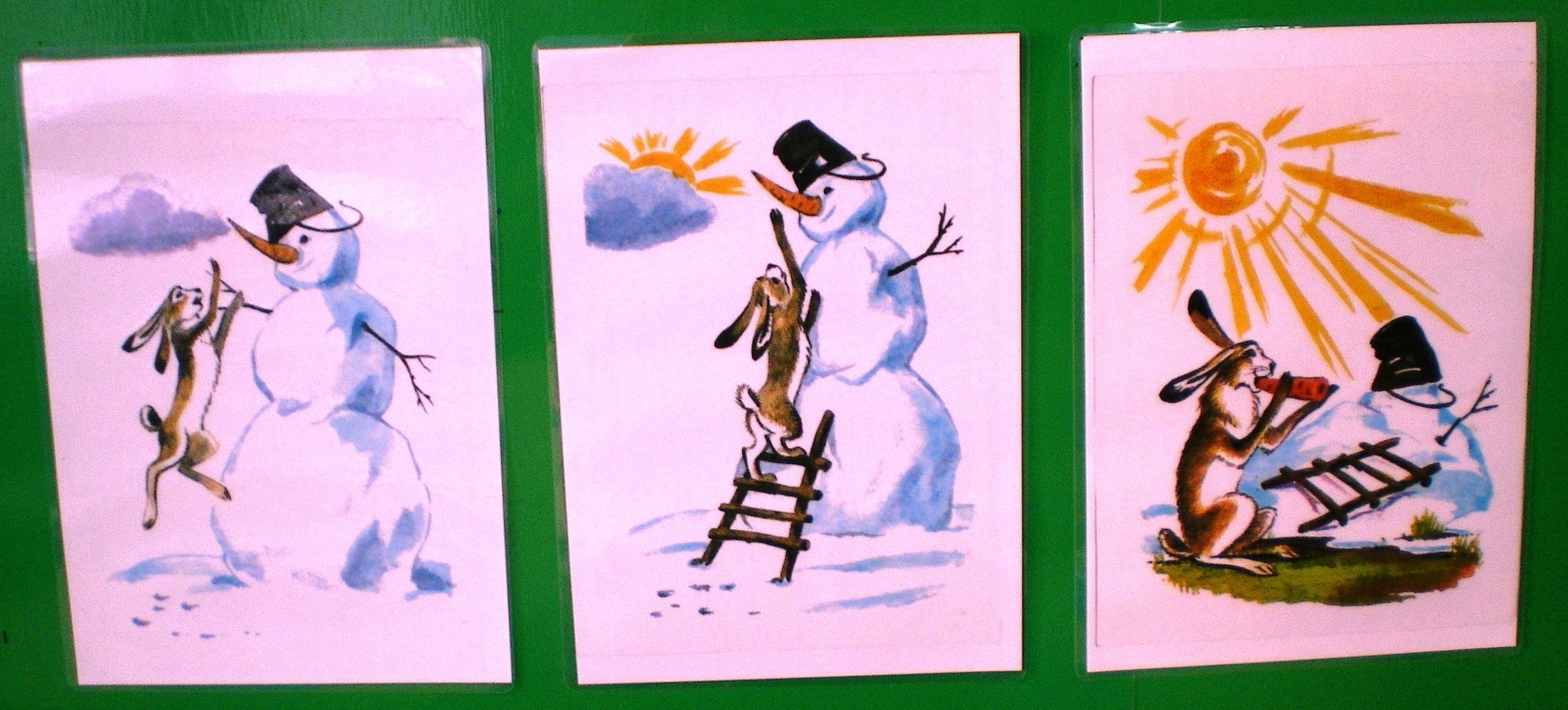
![]()

1. Agranovich Z.E. Collection of homework to help speech therapists and parents to overcome lexical and grammatical underdevelopment of speech in preschoolers with ONR / Z.E. Agranovich. - St. Petersburg. : CHILDHOOD-PRESS, 2003.
2. Gomzyak O.S. We speak correctly. Summaries of classes on the development of coherent speech in the group preparatory to school / O.S. Gomzyak. - M .: Publishing house GNOM and D, 2007.
3. Glukhov V.P. The formation of coherent speech of preschool children with a common speech underdevelopment/ V.P. Glukhov. - 2nd ed., Rev. and additional - M .: ARKTI, 2004. - (Library of a practicing speech therapist.)
4. Klimchuk N.I. visual modeling in the system of vocabulary work with children with general underdevelopment of speech. // Speech therapist. 2008.
5 Nechaeva N.E. Formation of inflection in preschool children with general underdevelopment of speech. // Speech therapist. 2008.
6. Ushakova O.S. Look and tell. stories by plot pictures. M., 2002.
7. Ushinsky K.D. Selected pedagogical works. M., 1968.
8. Z.E. Tkachenko T.A. We learn to speak correctly. Correction system general underdevelopment speech in children 6 years old. Handbook for educators, speech therapists and parents. - M .: "Publishing house GNOM and D", 2002.
9. Reader on the theory and methodology of the development of speech of preschool children: textbook. allowance for students. higher and avg. textbook establishments / comp. MM. Alekseeva, V.I. Yanshin. - M .: Publishing Center "Academy", 1999.
Beginning training for the next group: the 25th of October. Payment is possible in interest-free installments (10% at the beginning of training and 90% at the end of training)!
Apply for the course you are interested in now:
Similar content
451195 451088 451042 450989 450734 450660 450632
 Two heads and six legs; four walk, and two lie still
Two heads and six legs; four walk, and two lie still Self-esteem - what is it: concept, structure, types and levels
Self-esteem - what is it: concept, structure, types and levels Cassandra's Path, or Pasta Adventures War on Earth and Underground
Cassandra's Path, or Pasta Adventures War on Earth and Underground